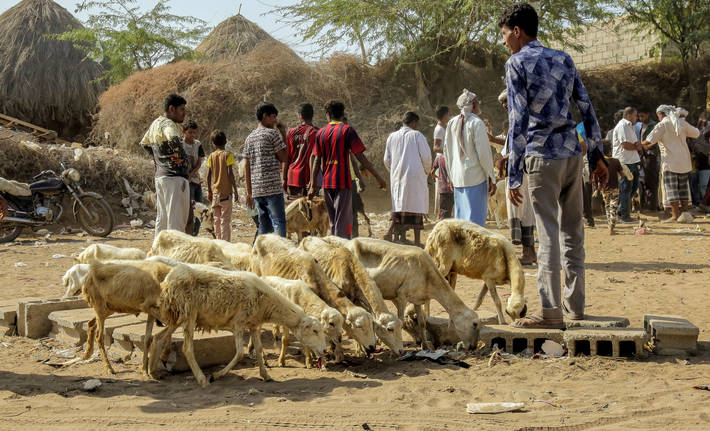Brussels, Belgium, Rome, Italy, and New York, New York, USA
21 April 2020
Joint EU / FAO / OCHA / UNICEF / USAID / WFP news release

People are gathering to vaccinate livestock such as cows and sheep in the targeted area supported by FAO, in Alhudaidah, Alzaydiah, Yemen.
Today an international alliance of UN, governmental, and nongovernmental agencies working to address the root causes of extreme hunger have released a new edition of their annual Global Report on Food Crises.
The report by the Global Network Against Food Crises, along with key findings, statements by partners, and multimedia products unpacking its contents are now available at:
Key findings of the Global Report
The report indicates that at the close of 2019, 135 million people across 55 countries and territories experienced acute food insecurity* (IPC/CH Phase 3 or above). Additionally, in the 55 food-crisis countries covered by the report, 75 million children were stunted and 17 million suffered from wasting in 2019.
This is the highest level of acute food insecurity* and malnutrition documented by the Network since the first edition of the report in 2017.
Additionally, in 2019, 183 million people were classified in Stressed (IPC/CH Phase 2) condition -- at the cusp of acute hunger and at risk of slipping into Crisis or worse (IPC/CH Phase 3 or above) if faced with a shock or stressor, such as the COVID-19 pandemic.
More than half (73 million) of the 135 million people covered by the report live in Africa; 43 million live in the Middle East and Asia; 18.5 million live in Latin America and the Caribbean.
The key drivers behind the trends analysed in the report were: conflict, (the key factor that pushed 77 million people into acute food insecurity), weather extremes (34 million people) and economic turbulence (24 million).
* Acute food insecurity is when a person's inability to consume adequate food puts their lives or livelihoods in immediate danger. It draws on internationally accepted measures of extreme hunger, such as the Integrated Food Security Phase Classification (IPC) and the Cadre Harmonisé. It is more severe than / not the same as chronic hunger, as reported on each year by the UN's annual State of Food Security and Nutrition in the World report. Chronic hunger is when a person is unable to consume enough food over an extended period to maintain a normal, active lifestyle.
About the Global Network
The Global Network against Food Crises seeks to better link, integrate and guide existing initiatives, partnerships, programmes and policy processes to sustainably address the root causes of food crises.
The Global Report on Food Crises is the flagship publication of the Global Network and is facilitated by the Food Security Information Network (FSIN). The Report is the result of a consensus-based and multi-partner analytical process involving 16 international humanitarian and development partners (in alphabetical order): the Comité Permanent Inter-Etats de Lutte contre la Sécheresse dans le Sahel (CILSS), the European Union (EU), the Famine Early Warning Systems Network (FEWS NET), the Food and Agriculture Organization of the United Nations (FAO), the Global Food Security Cluster, the Global Nutrition Cluster, the Integrated Food Security Phase Classification (IPC) Global Support Unit, the Intergovernmental Authority on Development (IGAD), the International Food Policy Research Institute (IFPRI), Sistema de la Integración Centroamericana (SICA), the Southern Africa Development Community (SADC), the United Nations Children's Fund (UNICEF), the United States Agency for International Development (USAID), the United Nations World Food Programme (WFP) the UN Office for the Coordination of Humanitarian Affairs (OCHA), and the UN Refugee Agency (UNHCR).